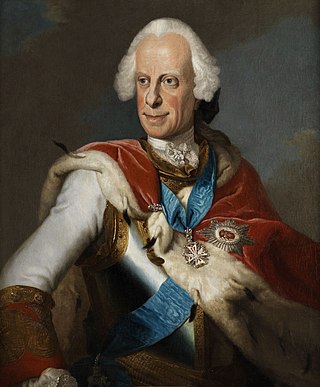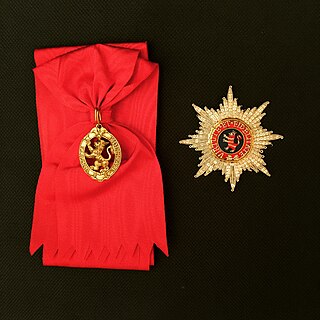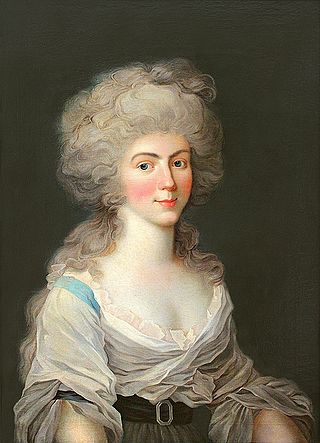
Louis I, Grand Duke of Hesse was Landgrave of Hesse-Darmstadt and later the first Grand Duke of Hesse and by Rhine.

Charles Louis, Hereditary Prince of Baden was heir apparent of the Margraviate of Baden.

Frederick II was Landgrave of Hesse-Kassel from 1760 to 1785. He ruled as an enlightened despot, and raised money by renting soldiers to Great Britain to help fight the American Revolutionary War. He combined Enlightenment ideas with Christian values, cameralist plans for central control of the economy, and a militaristic approach toward international diplomacy.

William I, Elector of Hesse was the eldest surviving son of Frederick II, Landgrave of Hesse-Kassel and Princess Mary of Great Britain, the daughter of George II.

Princess Wilhelmine of Baden, was by birth a Princess of Baden from the House of Zähringen and by marriage Grand Duchess consort of Hesse and by Rhine. Her descendants include King Charles III of the United Kingdom, King Felipe VI of Spain, and other members of European royalty.

Prince Frederick of Hesse-Kassel was a younger member of the ruling dynasty of the Landgraviate of Hesse-Kassel and a Danish general.

Louis VIII was the Landgrave of Hesse-Darmstadt from 1739 to 1768. He was the son of Ernest Louis, Landgrave of Hesse-Darmstadt and Margravine Dorothea Charlotte of Brandenburg-Ansbach.

Georg Donatus, Hereditary Grand Duke of Hesse was the first child of Ernest Louis, Grand Duke of Hesse, and his second wife, Princess Eleonore of Solms-Hohensolms-Lich. He was a nephew of Empress Alexandra and Emperor Nicholas II of Russia.

The House Order of the Golden Lion was an order of the German Landgraviate and Electorate of Hesse-Kassel and later, the Grand Duchy of Hesse and by Rhine. It was first instituted in 1770 by Landgrave Frederick II, in honour of and under the patronage of Saint Elizabeth of Hungary, an ancestor of the House of Hesse, and was intended to award auspicious merit.

Princess Augusta Wilhelmina of Hesse-Darmstadt was Duchess consort of Zweibrücken by marriage to Maximilian, Duke of Zweibrücken and the mother of King Ludwig I of Bavaria.

Caroline of the Palatinate-Zweibrücken was Landgravine of Hesse-Darmstadt by marriage to Louis IX, Landgrave of Hesse-Darmstadt. She was famed as one of the most learned women of her time and known as The Great Landgräfin.

Prince George William of Hesse-Darmstadt was a Prince of Hesse-Darmstadt. He was born in Darmstadt.

Maximilian of Hesse-Kassel was a prince of Hesse-Kassel and a Generalfeldzeugmeister, Generalfeldmarschall and finally Reichsgeneralfeldmarschall in the army of the Holy Roman Empire.

Friederike Charlotte of Hessen-Darmstadt was a princess of Hesse-Darmstadt and through her marriage a princess of Hesse-Kassel.

Princess Maria Amalia of Courland was a Landgravine of Hesse-Kassel by her marriage to Charles I, Landgrave of Hesse-Kassel. She was a daughter of Jacob Kettler, Duke of Courland and Semigallia and Margravine Louise Charlotte of Brandenburg. Her eldest son was King Frederick I of Sweden. One of her daughters was the most recent common ancestor of all the currently reigning monarchs of Europe from 1939 to 1941 and 1943 to 2022.

Caroline of Hesse-Darmstadt was Landgravine consort of Hesse-Homburg by marriage to Frederick V, Landgrave of Hesse-Homburg.

Frederick V Louis William Christian, Landgrave of Hesse-Homburg was from 1751 to his death landgrave of Hesse-Homburg.

Princess Louise Henriette Karoline of Hesse-Darmstadt, was the first Grand Duchess of Hesse and by Rhine by marriage.

Countess Maria Louise Albertine of Leiningen-Dagsburg-Falkenburg ; also known as Princess George, was heiress to the barony of Broich and by marriage Princess of Hesse-Darmstadt. She was the grandmother and educator of Princess Louise of Mecklenburg-Strelitz, who later became Queen consort of Prussia.

Louis William, Landgrave of Hesse-Homburg, was Landgrave of Hesse-Homburg from 1829 until his death.




















